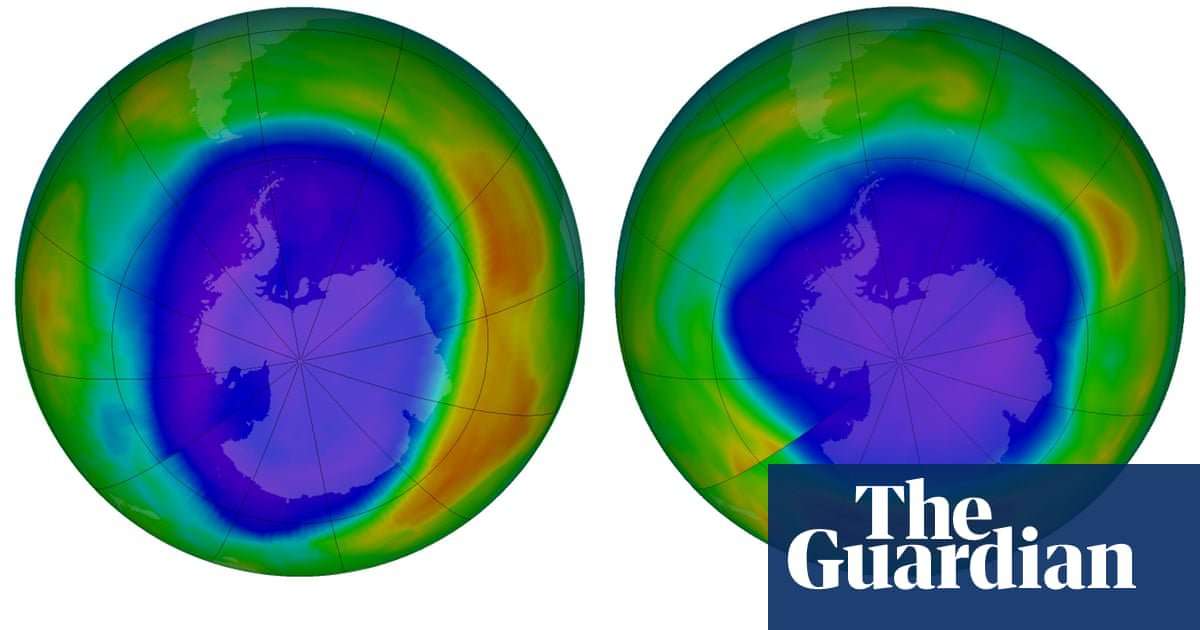The ozone layer is showing signs of continuing recovery from man-made damage and is likely to heal fully by 2060, new evidence shows.
The measures taken to repair the damage will also have an important beneficial effect on climate change, as some of the gases that caused the ozone layer to thin and in places disappear also contribute to warming the atmosphere. Phasing them out could avoid as much as 0.5C (0.9F) of warming this century.
Recovery from the holes and thinning caused by aerosol chemicals has progressed at a rate of about 1% to 3% a decade since 2000, meaning the ozone layer over the northern hemisphere and mid-latitudes should heal completely by the 2030s, if current rates are sustained.
Mysterious source of illegal ozone-killing emissions revealed, say investigators Read more
Over the southern hemisphere and in the more problematic polar regions, recovery will take longer, until the middle of this century in the former and about 2060 in the latter case.
The results, presented on Monday in a four-year assessment of the health of the ozone layer, represent a rare instance of global environmental damage being repaired, and a victory for concerted global action by governments. Scientific evidence of the depletion of the ozone layer over the Antarctic was first presented in 1985, and in 1987 the Montreal protocol was signed, binding world governments to reduce and phase out the harmful chemicals identified as causing the problem.
Ozone in the upper layers of the atmosphere protects the earth’s surface from most of the harmful ultraviolet rays from the sun. Without it, skin and eye damage can occur, and evidence suggests a rise in skin cancers associated with the thinning of the ozone layer.
“The Montreal protocol is one of the most successful multilateral agreements in history for a reason,” said Erik Solheim, head of UN Environment. “The careful mix of authoritative science and collaborative action that has defined the protocol for more than 30 years and was set to heal our ozone layer is precisely why the Kigali amendment holds such promise for climate action in future.”
The Kigali amendment to the Montreal protocol, coming into effect at the start of next year, will help reduce future climate change, by targeting HFC gases, mostly used in refrigeration, which have a warming effect tens of thousands of times greater than carbon dioxide.
Durwood Zaelke, president of the Institute for Governance and Sustainable Development, said: “Over the last three decades, the Montreal protocol has fulfilled its original objective to heal the ozone layer. But it didn’t stop there. Because CFCs and related gases are also super climate pollutants, phasing them out has reduced the climate problem by an amount that would have equalled the contribution of carbon dioxide today – more than half of all warming – with the Kigali amendment adding even more climate protection.”
Until recently, most major sources of ozone-harming gases were thought to have been closed down, until studies showed sites in China where gases were still emerging. The Chinese government has pledged to find and close down these sites.

blyat55 on July 1st, 2019 at 05:37 UTC »
Ozone action worked because it didn't require anyone to go without anything. We just switched to an equivalent chemical that does the same thing without quite the same ozone layer effects.
That's what separates this from climate change. It was a quick and easy fix that had no major impacts on anyone's lives.
Ggegfegds on July 1st, 2019 at 03:32 UTC »
Just in time for Zefram Cochrane to make first contact with the Vulcans
blitzskrieg on July 1st, 2019 at 03:20 UTC »
We could use a little less cancer down under